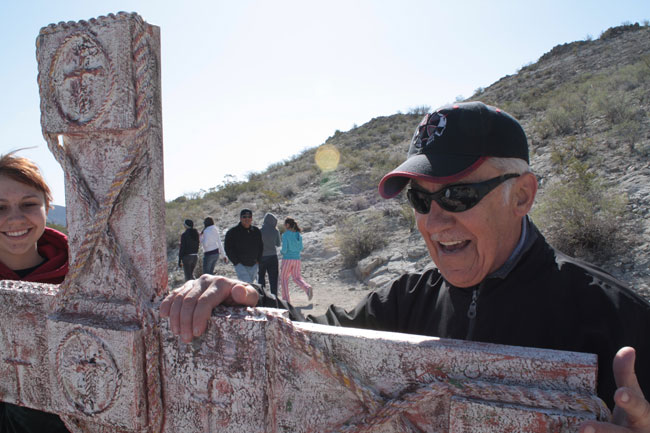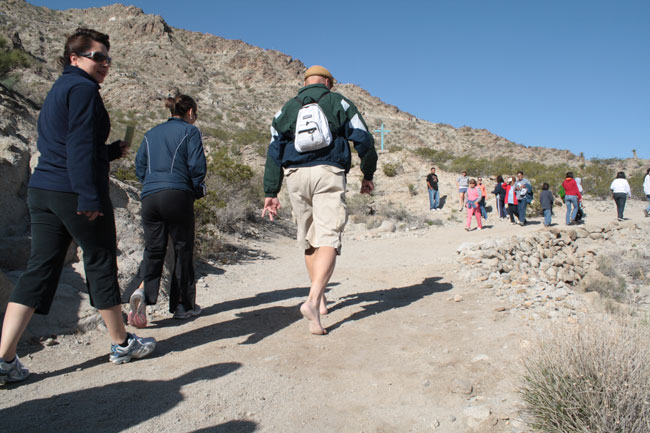
Pilgrims on its way to Mount Cristo Rey (Raymundo Aguirre/Borderzine.com)
EL PASO, Texas — Andre Karam carried the six-foot wooden cross for more than four miles up Mount Cristo Rey on Good Friday to relive the crucifixion of Jesus Christ.
He had trudged up this mountain every year for the past 35 years, but this was the first time he carried a cross on his back. It took him five weeks to finish it in faint white brushstrokes covering the ornamental details. A rope and round metal plates ran down the longest plank of the cross.
“They represent the five continents. One, two, three, four, five,” he said as he touched each plate. There was a foreign accent in his voice — different, even on the border. “The rope is Jesus pulling all the Christians for himself. This is what Jesus did: he came. We killed him and we blamed the Jews. We blamed the Romans, but we shouldn’t because every day it is we who put him on the cross.”
Ever since he made a different kind of pilgrimage 35 years ago —from Lebanon to America— Karam has been part of this event, which recreates the pinnacle of Christianity every Easter.
“I have been in this country 35 years. I come 35 times,” he said as he picked up his cross, ready to make the descent back to ordinary life.
Like him, thousands of people made their way to one of the holiest shrines in the area, atop of what was known as Mule Drivers Mountain before the 29-foot limestone statue of Christ was erected in 1939.

Andre Karam, originally from Lebanon, has come to Cristo Rey every year since he moved to America 35 years ago. (Raymundo Aguirre/Borderzine.com)
According to Ruben Escandon Jr., public relations director of the Mt. Cristo Rey Restoration Committee, Urbici Soler’s “Christ the King” received 6,800 visitors during Good Friday alone this year, not including the rest of Easter weekend. The dusty 4.4-mile journey attracts thousands of devout parishioners and faithful Christians every year. However, over time the numbers have decreased, Escandon said, perhaps this time because of the rough windy conditions the night before.
“This year it seems like probably about half of the [usual number of] people have come up here,” said Marta Ortega. “I’m sure the winds last night would’ve scared a lot of people.”
Ortega has been making the pilgrimage for the past 20 years, and in that time, she has noticed many changes on the mountain, including improved trail conditions, as well as an increase in Restoration Committee volunteers and Border Patrol agents to guard the area. She’s also noticed that pilgrimages done from the Mexican side of the border have changed considerably from those of years past.
“Way back when, the people from Mexico used to pilgrimage across the desert and come up the mountain,” she said, making upward clawing motions with her hands. “You used to see handfuls of people coming up all across, literally climbing up that mountain. That’s a real sacrifice.”
But sometimes the climb during high-traffic holidays would become more than a sacrifice and turn into an opportunity for people to enter the U.S. illegally.
“In years past (pre-2001) it was common for people to go up Cristo Rey from the Mexican side. Through good relations with the church and increased Border Patrol presence, that has dropped,” said Ramiro Cordero, special operations supervisor for the U.S. Customs and Border Protection Agency.
He added that detentions made during the Easter holiday have decreased drastically over the years.
“Any time there is a pilgrimage scheduled, the Border Patrol is advised by the Las Cruces Diocese, and the Santa Teresa station ensures that there is a sufficient number of agents in the area,” he said.
Families of all sizes, church groups and single individuals made the walk to the 12 stations set throughout the trail and marked by green iron crosses. The “Via Crucis,” or Way of the Cross, represents the final hours of Jesus Christ as he made his way to the site of his crucifixion.
Many people ascend barefoot, as a means of sacrifice and gratitude to Jesus Christ. Others have a deeper compromise to fulfill, as their pilgrimages are promises made to God for loved ones.
Cleto Alvarez has been making the pilgrimage for the past eight years. The 80-year-old man wielded a cane that was almost his height. With it, he led his family’s yearly journey full of gratitude and faith.
“For now, I don’t feel too fatigued,” he said in Spanish. “This might be the last time, who knows. But it’s a promise for one of my daughters. She had breast cancer and she survived by the grace of God.”

Many people ascend barefoot, as a means of sacrifice and gratitude to Jesus Christ. (Raymundo Aguirre/Borderzine.com)
